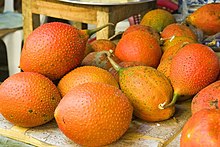Momordica cochinchinensis
| Momordica cochinchinensis | ||||||||||||
|---|---|---|---|---|---|---|---|---|---|---|---|---|

Momordica cochinchinensis |
||||||||||||
| Systematics | ||||||||||||
|
||||||||||||
| Scientific name | ||||||||||||
| Momordica cochinchinensis | ||||||||||||
| (Lour.) Blast. |
Momordica cochinchinensis or Gacfrucht , Gac fruit or baby jackfruit is a plant from the family of cucurbits (Cucurbitaceae). Their fruits are used as vegetables in Asia.
features
The plants are climbing plants with thick, woody, up to 20 meters long shoot axes . The leaves , up to 20 centimeters in size, are three to five lobes with pointed lobes and heart-shaped in outline. The edges are whole and dentate, the petiole is slightly hairy. The nerve is prominently imprinted. The tendrils are simple.
The plants are mostly dioecious , monoecious ones are also known from India . The large, five-fold flowers with a double flower envelope are usually single in the leaf axils and are cream-colored to pale yellow with black marks in the throat.
The male flowers, with a blackish and five-lobed calyx, are stalked up to 12 centimeters long. They have five, three united, fused stamens. The flowers are underlaid by large bracts . The female flowers, with a calyx with five blackish and narrow lanceolate tips, are stalked up to 10 centimeters. There is a small cover sheet. The unilocular ovary is inferior and slightly below the cup (epiperigyn), the scar consists of three parts. Staminodes may be present.
The beaked and leathery berries (armored berries , pepo) are egg-shaped, 10 to 20 cm long and can weigh 1 to 1.5 kg. They have small, conical, pointed bumps and are orange to red in color when ripe. Embedded in the red seed coat (false aril ) are many, sculpted, flat, brown-greyish seeds with a wavy, serrated edge, up to 1.8-2.8 centimeters in size .
The Vietnamese gac fruit contains the highest known amount of lycopene in a fruit and is consumed in Vietnam and the surrounding countries mainly because of its considerable beta- carotene content in order to prevent the vitamin A deficiency diseases that are common in these regions.
The gac fruit contains more carotenoids than carrots (10 times higher than carrots µg / g fresh weight) and more lycopene than tomatoes (70 times higher than a tomato µg / g fresh weight).
The number of chromosomes in the plant is 2n = 28.
distribution
The homeland of the species is believed to be in India , but it is cultivated in all of South and Southeast Asia and is also naturalized there.
Cultivation and use
The cultivation takes place mostly during the rainy season in the hot, humid tropics. Irrigation is necessary in other areas. The unripe, one to two week old fruits are harvested. Diseases are rare, fruit flies can cause some damage to the fruit.
The unripe fruits are cooked after removing the tips and used as vegetables or in curries . Young leaves, flowers, and seeds are also edible. The oil from the seeds can be used for lighting.
The roots are rich in triterpene - saponins and are used as a soap substitute. In China, India and generally in South Asia, various parts of the plant are used medicinally.
literature
- RW Robinson, DS Decker-Walters: Cucurbits. CAB International, Wallingford 1997, ISBN 0-85199-133-5 , pp. 100 f.
- BK Ishida, C. Turner, MH Chapman, TA McKeon: Fatty acids and carotenoid composition in gac (momordica cochinchinensis spreng) fruit. In: Journal of Agricultural and Food Chemistry . Vol. 52, 2004, pp. 274-279.
Web links
Individual evidence
- ↑ Momordica cochinchinensis at Tropicos.org. In: IPCN Chromosome Reports . Missouri Botanical Garden, St. Louis


